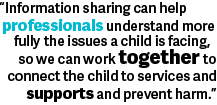Building a partnership that engages key stakeholders is essential for information sharing. To begin, consider including in the partnership a representative from each of the following systems:
- Schools
- Law enforcement
- Juvenile justice
- Mental health
- Child welfare
Every community has a unique approach to collaborating for information sharing. Your community may already have a partnership of youth-serving organizations that’s ready and willing to tackle the issue of information sharing, or you may need to launch a new collaborative effort. The following examples illustrate how two districts set up their partnerships:
- In Helena, Montana, the school district’s community resource and referral coordinator brought together the school district’s attorney, an independent consultant with HIPAA expertise, the deputy county attorney, and a School Resource Officer to determine how the organizations would share information about children served by multiple systems. This group trained school and youth-serving professionals in the community about the essential elements of HIPAA, FERPA, federal drug and alcohol confidentiality laws, and state codes. The group members continue to work together to resolve new information-sharing challenges that arise.
- The Grossmont Union High School District in Southern California developed an interagency agreement to share information with local law enforcement, mental health, probation, and social service agencies. The mental health and law enforcement agencies each appointed staff to promote information sharing internally, and one of the social service agencies facilitates monthly meetings of all partners to review information-sharing procedures.
Visit the Partner section on the 3 Bold Steps home page to learn more about how to bring the right partners to the table, make the case for their involvement, and build a sense of shared leadership and ownership among partners.
